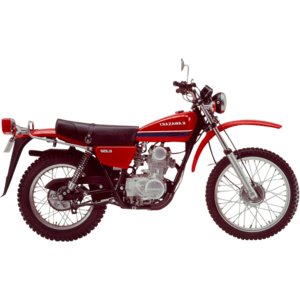Kawasaki KL 250 (1978–1983) Review: The Unstoppable Dual-Sport Pioneer
Introduction
The Kawasaki KL 250 is a motorcycle that refuses to fade into obscurity. Produced between 1978 and 1983, this air-cooled single-cylinder dual-sport has carved its name into the annals of motorcycling history as a rugged, no-nonsense machine that thrives both on asphalt and dirt. While modern adventure bikes prioritize tech and horsepower, the KL 250 reminds us why simplicity and reliability are timeless virtues. After spending a week with a meticulously preserved 1981 model, it’s clear why this bike still has a cult following—and why it’s a perfect candidate for customization or restoration using aftermarket parts from MOTOPARTS.store.
Design & Ergonomics: Function Over Flair
The KL 250’s design is a masterclass in utilitarian aesthetics. Its high-mounted fenders, slim steel frame, and minimalist bodywork scream “workhorse.” The narrow seat (which feels firmer than a park bench) and upright handlebars prioritize functionality over luxury, but there’s a certain charm to its straightforwardness. At 135 kg (298 lbs), it’s light enough to maneuver through tight trails yet stable enough for highway cruising—a balance few modern dual-sports achieve.
The instrumentation is sparse: a speedometer, odometer, and neutral indicator. No fuel gauge or tachometer here—riders are expected to listen to the engine and plan ahead. The lack of clutter keeps the bike’s profile lean, and the chrome accents on the exhaust and side panels add just enough flair to keep it from looking too austere.
Engine & Performance: Modest Power, Maximum Durability
At the heart of the KL 250 lies a 246 cc air-cooled single-cylinder engine producing 17 PS (13 kW). By today’s standards, those numbers seem humble, but the engine’s torquey character shines off-road. The carbureted powerplant delivers smooth, predictable throttle response, with peak torque arriving low in the rev range. It’s happiest chugging along at 80–90 km/h (50–56 mph), though it’ll grudgingly push to 110 km/h (68 mph) if you tuck in and endure the vibrations.
Starting the bike is a ritual: a firm kick on the lever (no electric start here) rewards you with a throaty, rhythmic exhaust note. The engine’s vibrations are noticeable but never intrusive, fading into the background once you’re moving. What it lacks in speed, it makes up for in bulletproof reliability. This is an engine that’ll outlast the apocalypse if maintained properly—more on that later.
On-Road Handling: Surprisingly Nimble
On paved roads, the KL 250 feels like a supermoto prototype. The narrow 3.00-21 front tire and 4.10-18 rear (common sizes for the era) offer enough grip for spirited cornering, and the 135 kg weight makes it flickable in city traffic. The suspension—a basic telescopic fork up front and dual shocks at the rear—is tuned for compliance, soaking up potholes without wallowing.
The mechanical drum brakes require deliberate input, especially when wet, but they’re adequate for the bike’s performance envelope. Just don’t expect ABS-level confidence during panic stops.
Off-Road Capability: Where the KL 250 Truly Shines
Dirt is this bike’s natural habitat. The long-travel suspension (200 mm front and rear) and 250 mm ground clearance let you tackle rocky trails and shallow streams with ease. The upright riding position provides excellent visibility, and the low seat height (830 mm/32.7") inspires confidence for shorter riders.
The 14/40 sprocket combination and 96-link chain strike a perfect balance between low-end grunt and highway usability. On steep inclines, the KL 250 crawls upward like a mountain goat, rarely demanding a clutch slip. Just keep the tire pressure at 1.5 bar (22 psi) front and 1.8 bar (26 psi) rear for optimal traction.
Competition: How Does It Stack Up?
The KL 250’s main rivals in the late ’70s/early ’80s dual-sport segment were the Yamaha XT250 and Honda XL250S. Here’s how they compare:
- Yamaha XT250: Lighter (128 kg) and slightly more powerful (21 PS), the XT250 had a edge in acceleration. However, its suspension was softer, making it less stable at high speeds. The KL 250’s sturdier frame and better corrosion resistance gave it an advantage for long-term ownership.
- Honda XL250S: Honda’s offering had a smoother engine and better road manners, but its complex twin-carb setup was finicky compared to the KL 250’s single carb. Maintenance costs tilted in Kawasaki’s favor.
Modern equivalents like the Suzuki DR200S or Honda CRF300L offer fuel injection and modern suspension, but they lack the KL 250’s mechanical simplicity and vintage appeal. For riders who enjoy wrenching as much as riding, the Kawasaki is a more engaging partner.
Maintenance: Keeping the Legend Alive
The KL 250 is a mechanic’s dream—or a novice’s best friend. Here’s what owners need to know:
Valve Adjustments
- Intake: 0.08–0.13 mm (0.003–0.005 in)
- Exhaust: 0.17–0.22 mm (0.007–0.009 in)
Check every 3,000 km (1,864 miles). Use a feeler gauge and MOTOPARTS.store’s valve adjustment kit for precise results.
Spark Plugs
- Primary: NGK BR7ES (standard)
- Alternative: NGK BR7EIX (iridium, longer lifespan)
Gap to 0.8 mm (0.031 in). Replace annually for optimal combustion.
Oil Changes
- Without filter: 1.1 L of SAE 20W-40
- With filter: 1.4 L
Use MOTOPARTS.store’s synthetic-blend oil for improved heat dissipation.
Chain Care
The 96-link chain and 14/40 sprockets require regular lubrication. Upgrade to an O-ring chain from MOTOPARTS.store for reduced maintenance.
Brakes
Sticking with the original mechanical drums? Keep the actuation arms clean and replace brake shoes before they wear below 1 mm thickness.
Conclusion: A Timeless Adventure Companion
The Kawasaki KL 250 isn’t just a motorcycle—it’s a testament to an era when bikes were built to endure. Its straightforward mechanics, lightweight chassis, and go-anywhere attitude make it a joy for vintage enthusiasts and practical commuters alike. While it won’t win drag races, few bikes today can match its character or cost-of-ownership smile.
Whether you’re restoring a barn find or upgrading your daily rider, MOTOPARTS.store has the parts to keep your KL 250 running for another 40 years. From NGK spark plugs to heavy-duty chains, we’ve got your back. Now get out there and ride—the trails are waiting.



















